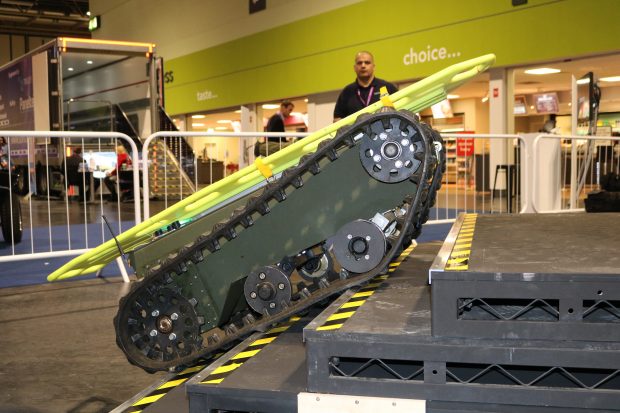Barrnon and Wood progress in nuclear innovation contest
Decommissioning of highly radioactive facilities could see significant cost reductions thanks to technology developed for industries including gaming and sea-fishing.

Related Articles
A consortium led by Barrnon is one of two that have reached the next round of an innovation competition that could help decommissioning of highly radioactive facilities.
The UK-based company says its Barrnon Integrated Decommissioning System (BIDS) could provide significant cost reductions.
“The BIDS system is a complete change of methodology in nuclear decommissioning,” Barrnon Project Director David Main told Nuclear Energy Insider.
“A highly radioactive area that has very limited human access either cannot be dismantled or requires many teams of technicians to carry out simple tasks. A conservative estimate would be a relative cost reduction of 300% based on a BIDS system with two operators.”
The Nuclear Decommissioning Authority's (NDA) latest 2019 forecast is that future clean-up across the UK will cost around 124 billion pounds ($162 billion) with more than 75% of that cost attributed to the Sellafield site.
 Launched in 2017, the 8.5 million pound ($11.1 million) Integrated Innovation in Nuclear Decommissioning (IIND) competition was funded by the NDA, Innovate UK and BEIS. The first stage of the competition identified 15 submissions with potential, and five were subsequently shortlisted. The two projects moving forward are consortia led by Barrnon and Wood.
Launched in 2017, the 8.5 million pound ($11.1 million) Integrated Innovation in Nuclear Decommissioning (IIND) competition was funded by the NDA, Innovate UK and BEIS. The first stage of the competition identified 15 submissions with potential, and five were subsequently shortlisted. The two projects moving forward are consortia led by Barrnon and Wood.
After testing integrated working models in a realistic non-radioactive environment, the projects will now progress to demonstrating their solutions in one of Sellafield’s radioactive facilities.
The challenge was to gain access to spaces that have been sealed for a number of years, establish the nature of the contents, accurately measure radioactivity levels, and deploy robotic equipment to cut up large items (including large vessels and pipework), segregate the waste and retrieve it for safe storage.
Step change
The winning projects demonstrated innovative solutions which integrated a range of technologies and capabilities and have the potential to enable a step change for nuclear decommissioning, according to NDA.
Industries as diverse as computer gaming, fume extraction, sea-fishing, medical imaging, oil and gas as well as space and defence have all been represented.
“BIDS is a remotely operated platform for deploying characterisation, decontamination and size-reduction tools via a Virtual Reality control environment,” says Main. “The system is fully scalable and configurable to tackle any hostile environment without human access. It can be configured to deploy any hydraulic, electrical or pneumatic tool.
“This technology is applicable to many nuclear sites around the world. We are already in discussions with our other global clients who are interested in how this technology could work for them in tackling their decommissioning challenges.”
BIDS uses a VR User Environment to combine multiple views of the environment (cameras, point cloud model and CAD representations) with control over multiple robots and tools. The operator is fully immersed in this virtual control system, able to access all the data and views that they need to effectively plan and deconstruct a cell.
Located at a safe distance, the operator can view the resulting 3D image, effectively walking around, analysing the topology and inspecting the location of radiation hotspots. Remaining within the virtual control room, a hand-held scanner can be used to scan a specific area for alpha and beta contamination. The operator can use an array of tools to decontaminate and dismantle the infrastructure, including laser cutting, circular saw, stud welding, sludge removal and blasting with liquid nitrogen.
Barrnon partnered with Createc (LiDAR and radiation scanning) and Cambrian Intelligence (virtual reality and robotics) on the BIDS project.
Pushing innovation
Wood says its successful project is anchored in the reality of the current decommissioning landscape but uses innovation to push into under-developed areas.
According to Wood, technologies in their new system include novel material-handling solutions, designed to reduce the risks associated with working at height; advanced sensing systems; and advanced gripping and grasping technology which simplifies handling of irregular shapes.
Wood has partnered with Airbus Defence and Space, Clicks and Links, Damavan Imaging, Digital Concepts Engineering, IS-Instruments, I3D Robotics, The University of Lancaster, The University of Salford, and TWI.

Wood's project uses the X-2 ROV, designed by Digital Concepts Engineering. Image: Wood
A number of the technologies put forward in the competition were tried and tested in the nuclear industry, while some were established in other industries, and some completely new. The winning project – or projects – could be put to work at Sellafield’s Thermal Oxide Reprocessing Plant (THORP) and Magnox Reprocessing Plant, which are both due to close by 2020.
“This competition presented a unique opportunity to develop groundbreaking technologies in innovative ways,” said Barrnon’s David Main. “Barrnon will now engage closely with Sellafield in a direct contract to deliver the technology on-site to demonstrate its capabilities in an active environment.”
Scott Birch
